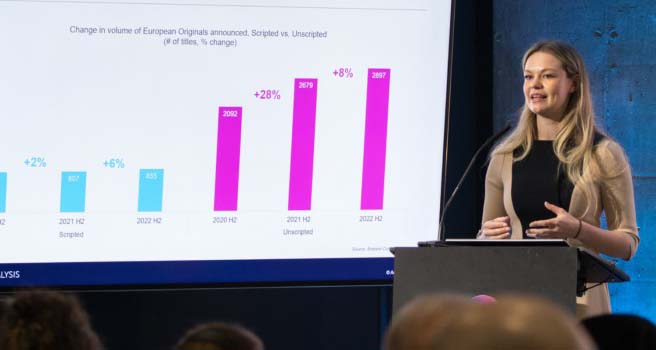One of the first conferences of insights during MIPJunior 2024 edition had Olivia Deane, Research Manager at Ampere Analysis, who addressed a conference on how children’s media consumption has evolved over the past two decades, with significant changes in content delivery models and industry strategies.
The conference reflects on the own experience of Deane, who also recalled how watching the X Files on YouTube in 2007 reshaped her understanding of media consumption, highlighting the shift towards on-demand content.

Deane outlined a timeline that began with the early days of on-demand viewing (2004-2014), when children gained increased access to digital content across multiple devices. Streaming platforms responded to this demand by significantly investing in children’s programming, which became a key focus for many commissioners.
‘This led to a rapid increase in children’s content commissioning, particularly during the OTT boom from 2014 onward, what i call OTT golden years’, said. In fact, the exec commented that by 2021, children’s and family content ranked as the third most acquired genre on streaming platforms, with 18,000 titles.
The concsultancy firm assured that however, the market eventually became saturated, ‘by mid-2024, streaming platforms offered enough children’s content to cover 43 years of continuous viewing. Despite a rise in streaming service subscriptions, the industry faced challenges, as commission rates began to decline starting in 2023’.
In figures, the presetation shows that children’s content was one of the most impacted genres, with a 13% reduction in commissions during the first half of 2024 compared to the previous year. ‘Although streamer commissions dropped, we noted that acquisitions of children’s content rose, with Netflix increasing acquisitions by 7% and Apple by 16% between 2023 and 2024’.
Lastly Deane emphasized the opportunities for independent creators, citing examples like Ankama’s Wakfu and the YouTube hit Lukas the Spider. Despite market saturation, she highlighted the potential for success through creative funding models and partnerships with established brands or IPs, which can offer a competitive advantage in the evolving media landscape. As well as the role of public broadcasters, which continue to play a crucial role in the market, prioritizing the renewal of existing content, with their focus shifting towards reliable, popular programming.







